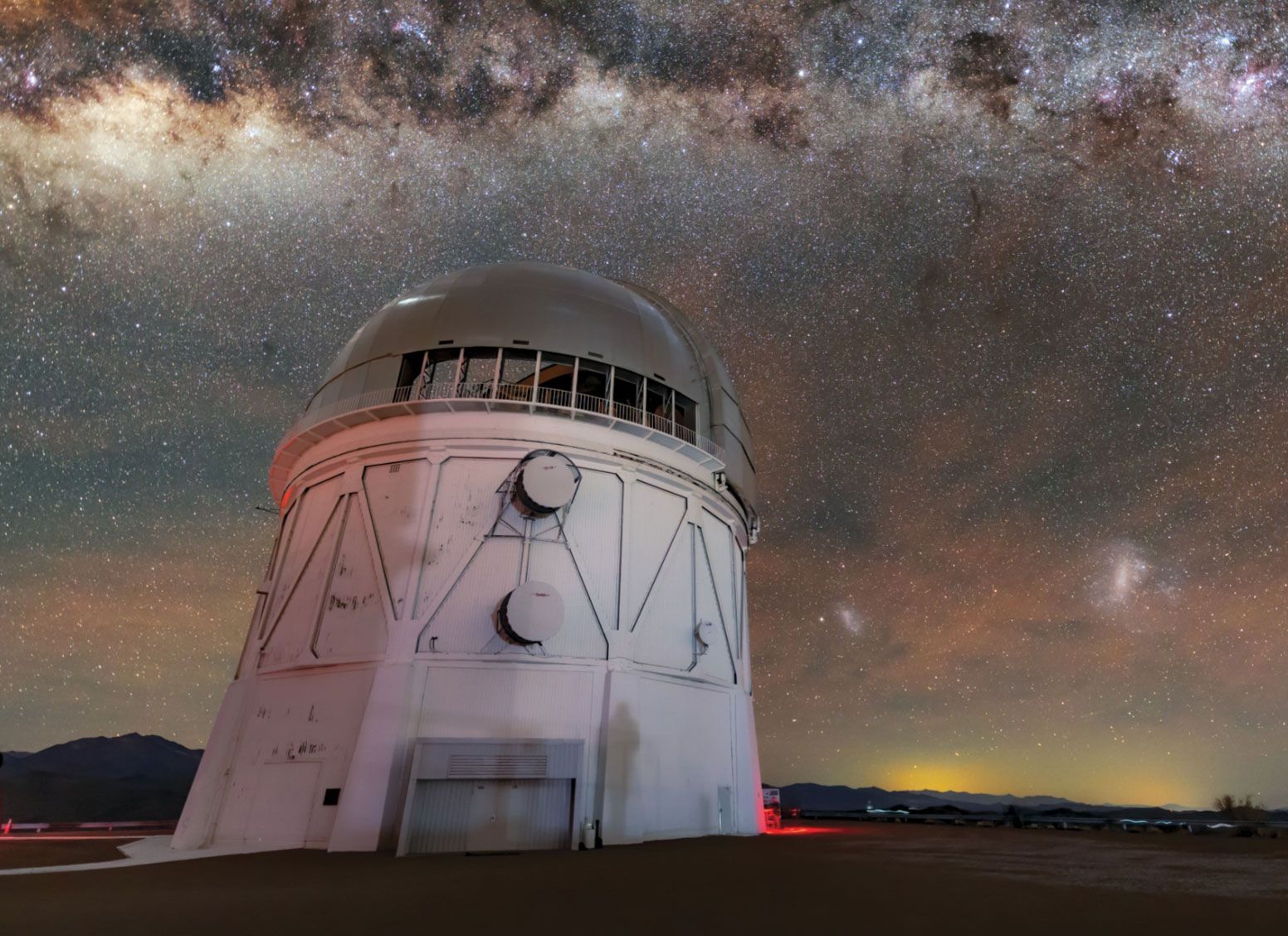Unifying two fields
DOI: 10.1063/PT.3.4883
Although astronomy has been a part of physics for centuries, it maintained a separate culture until the relatively recent realization that some central problems in fundamental physics were best attacked using astronomical techniques. I can remember a time when I served on a Department of Energy panel and was advised never to use the word “telescope,” because higher-level committees would frown on the unwanted incursion into astronomy. Equally telling is the warning I received as an undergraduate in the 1970s: Only “failed physicists” go into astronomy. That is no longer true. The two cultures are now conjoined by cosmology, and there is little distinction between astronomers and astrophysicists.

The Dark Energy Survey’s imaging camera was mounted on the Víctor M. Blanco 4-meter Telescope at the Cerro Tololo Inter-American Observatory in Chile, which is pictured here under the night sky with part of the Milky Way visible.
CTIO/NOIRLAB/NSF/AURA/R. SPARKS/CC BY 4.0

The Dark Energy Survey: The Story of a Cosmological Experiment documents a collaboration that epitomizes the recent melding of those two cultures. As the title suggests, it outlines how physicists and astronomers successfully attacked one of the most perplexing questions in physics: What explains the accelerated expansion of the universe? The book chronicles the collaboration’s history from its genesis as a mere idea in 2003 through the six-year observational program it ran from 2013 to 2019. As one might expect, the book presents an informative overview of the project’s many scientific discoveries. But it is equally valuable for its depiction of the nuts and bolts of fashioning an experiment spanning different scientific cultures and funding agencies.

The centerpiece of the Dark Energy Survey (DES) was an imaging camera built for the project and mounted at the prime focus of the Víctor M. Blanco 4-meter Telescope at the Cerro Tololo Inter-American Observatory in Chile. In each pointing, the camera observed 3 square degrees in five colors. The resulting observations were mosaicked together to form a final composite image that spanned 5000 square degrees. Researchers used four different methods, set out in 2006 by the US Dark Energy Task Force, to achieve the overarching goal of measuring the cosmological equation-of-state parameter w with an accuracy of a few percent.
The book provides an excellent description of the science behind those four methods and delves deep into the details of data taking, computer modeling, scientific management, and the search for hidden uncertainties in the results. Its depiction of the ways in which DES scientists guarded against confirmation bias is especially interesting. They kept the intermediate results of the four primary methods hidden by blinding the analysis of the data. Only at the very end was the final result of the experiment—which found that w is closely consistent with the cosmological constant first postulated by Albert Einstein—revealed to the investigators. The blinding gave the scientific community confidence that the result reflects the data and not the scientists’ expectations.
The histories of important experiments are often written well after the fact and can be unconsciously shaped by the memories of a few individuals who worked on those experiments—namely, those who write down their recollections. The account of the DES in the present book will be important for historians of science because it was written during the final stages of the project and not years later, when its full impact will have been realized. Each chapter was written by different groups of authors and emphasizes different aspects of the project’s evolution.
The Dark Energy Survey is unique because it is neither a pure narrative of a project nor a review article about scientific discoveries. Aside from historians, the audience for such a book is not apparent. At times it feels as if the intended audience is the DES collaboration itself—it includes details that could only be interesting to those that were part of the history. But that is not a criticism, because the book comes off as an honest and intimate telling of the history. The flow of the prose is choppy, because a different group wrote each chapter, and readers will likely skip to the sections that interest them most.
The final chapters include observations of the collaboration by anthropologists, a philosopher, and artists in residence. The book ends with a poem by Amy Catanzano, which in part reads,
Here at Cerro Tololo,
a furnace of galaxies
spirals the heart,
weaving sparks
and thick
mists –Each galaxy is a performancehypnotizing space
We don’t think of the scientific practice as being anything like a theatrical performance, but in some ways it is. In my generation, astronomers observed and physicists did experiments. The past cultures of astronomy and physics evolved their own distinct personalities. The book describes an important milestone in the history of the unification of the two fields and provides an excellent summary of the methods used to explore one of the greatest mysteries in physics today: dark energy. Not every reader will find every chapter interesting, but all readers with science backgrounds will find in some chapters a mirror of their experience.
More about the Authors
Nicholas Suntzeff is a professor of observational astronomy at Texas A&M University. Along with Brian Schmidt, he cofounded the
Nicholas B. Suntzeff. Texas A&M University, College Station.
